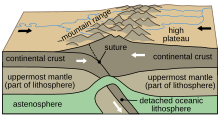A granitoid is a generic term for a diverse collection of coarse-grained igneous rocks that consist predominately of quartz, plagioclase, and alkali feldspar.[1] Granitoids range from plagioclase-rich tonalites to alkali-rich syenites and from quartz-poor monzonites to quartz-rich quartzolites.[2] As only 2 of the 3 defining mineral groups (quartz, plagioclase ,alkali feldspar) need to be presence to be a Granitoid, foid-bearing or feldspathoid rocks, meaning rocks predominately containing feldspars but no quartz, are also granitoids.[2] The terms ‘granite’ and ‘granitic rock’ are commonly used interchangeably for granitoids; however granite is just a particular type of granitoid.

Granitoids are diverse: no one classification system for granitoids can give a complete and unique characterization of the origin, compositional evolution and geodynamic environment for the genesis of a granitoid. Accordingly, multiple granitoid classification systems have been developed such as those based on: geochemistry, modal content, emplacement depth, and tectonic regime.
Granitoid generalizations

There are several generalizations that apply to majority of granitoids. Typically, granitoids occur where orogeny thickens continental crust either by subduction yielding a continental arc or by convergence yielding continental collisions.[3] Generally, the evolution to granitoid magmas requires a thermal disturbance to ascent though continental crust.[3] Most granitoids are generated from crustal anatexis, the partial melting of the crust; however the mantle may contribute both heat and material.[3] Granitoids can occur coeval with volcanic rocks that have equivalent chemical composition ( granites-rhyolites, syenite-trachyte, dacite-granodiorite etc.) however, these extrusive rocks are often eroded so just the plutonic rocks outcrop.[3] Granitoids can form in all tectonic environments.[3]
There are numerous exceptions to these generalizations.[4][3] For example, granitoids can form in anorogenic environments, a granitoid source rock can be from the mantle (ex. intraplate hotspots) and the melting mechanism can be radiogenic crustal heat.
| This article uses material from the Wikipedia article Metasyntactic variable, which is released under the Creative Commons Attribution-ShareAlike 3.0 Unported License. |